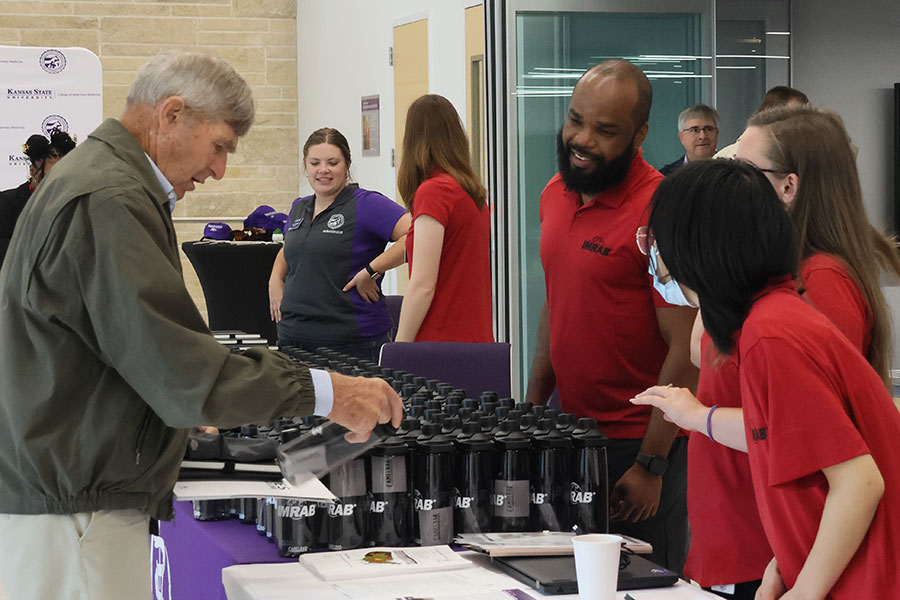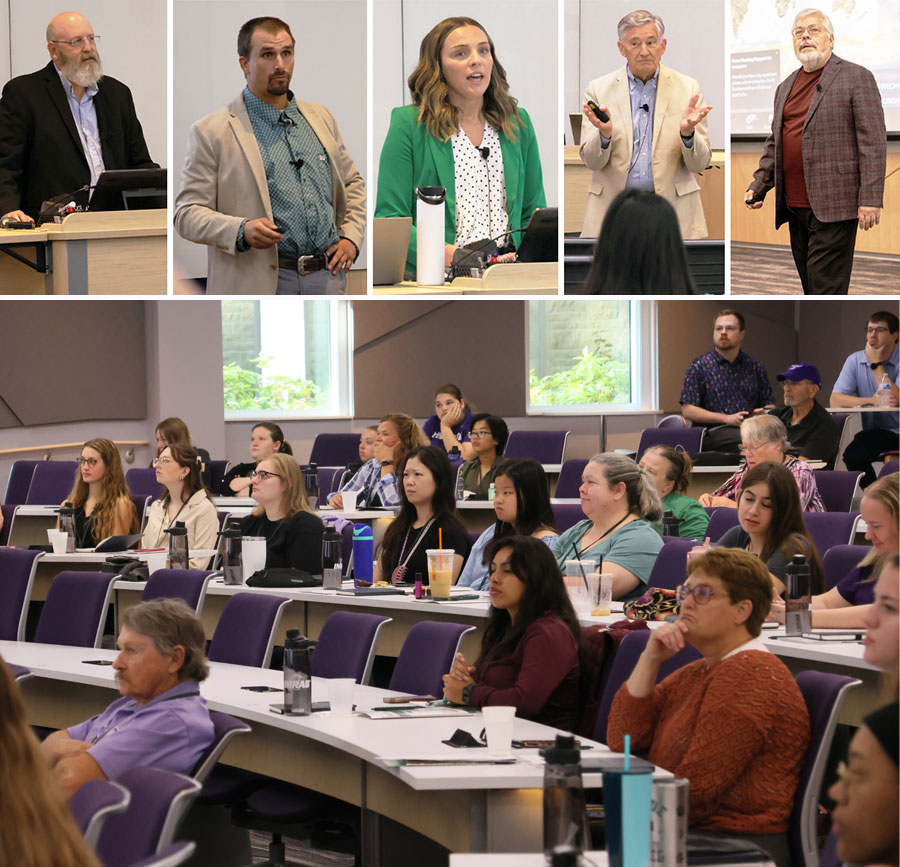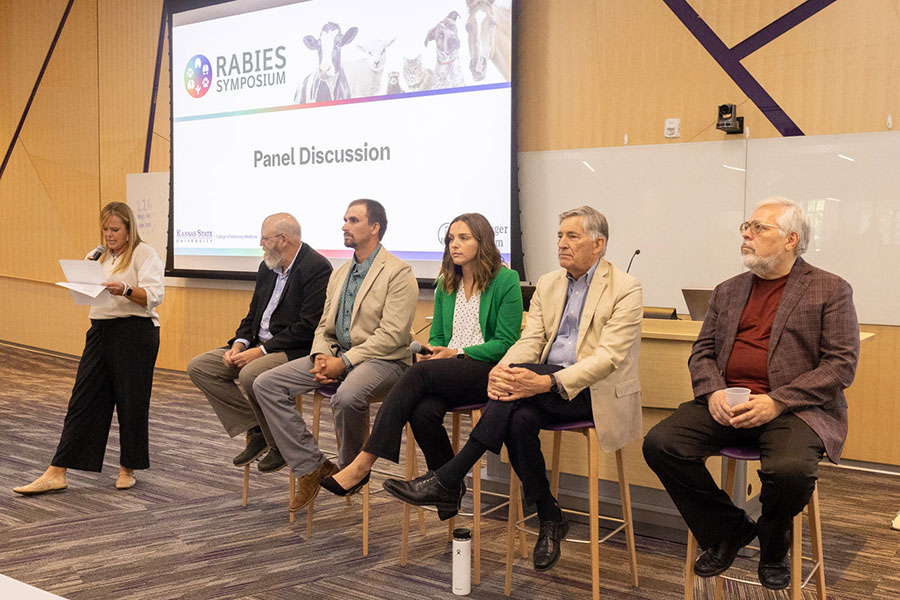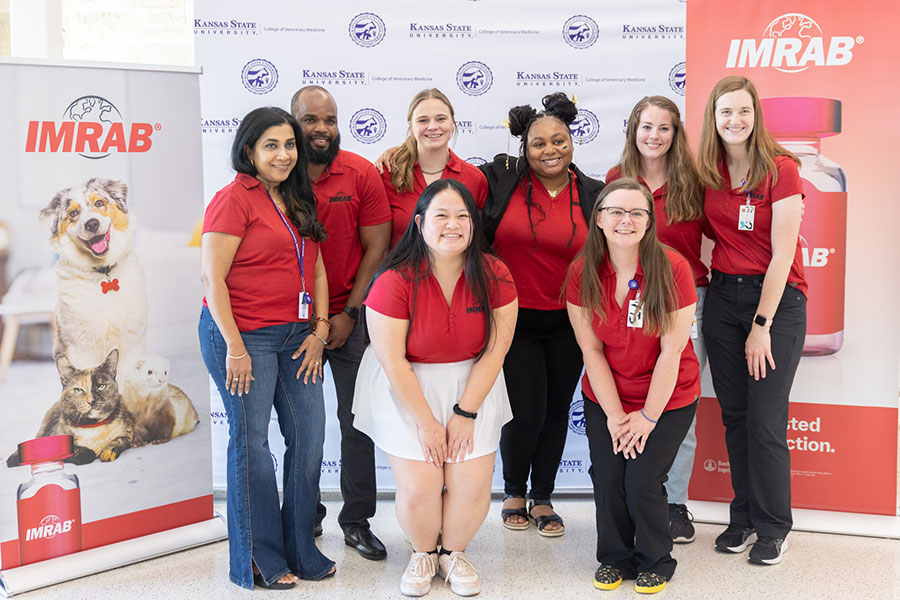CVM hosts collaborative Rabies Educational Symposium for World Rabies Day 2024

Dr. Larry Ringel, DVM class of 1969, checks in at the registration desk for the 2024 Rabies Symposium. (Photo by Joe Montgomery)
In commemoration of World Rabies Day 2024, the College of Veterinary Medicine, in collaboration with Boehringer Ingelheim Animal Health and the Kansas State University Veterinary Diagnostic Lab, hosted the 2024 Rabies Symposium in October. The hybrid event was held in person at the Boehringer Ingelheim Animal Health Auditorium and virtually via Zoom.
The symposium featured several experts in the field of rabies who detailed the impact of rabies on a local and global scale. Speakers included: Richard Chipman, wildlife biologist from New Hampshire who spoke on wildlife rabies management; small animal practitioner Dr. Mark Spare, DVM 2019, who shared a case report of a rabid cow; Stephanie Lindmann, epidemiologist with the Kansas State Department of Health and Environment who shared updates on post exposure prophylaxis for rabies; Richard Ford, professor at North Carolina State University, who shared critical issues surrounding rabies vaccinations; and global rabies expert Dr. Charles Rupprecht. More than 150 people attended in person and 225 attended virtually.

The guest speakers enjoy a large audience at the symposium: From left: Rich Chapman, Dr. Mark Spare, DVM class of 2019; Stephanie Lindemann, Dr. Richard Ford and Dr. Charles Rupprecht. (Photos by Joe Montgomery and Audrey Hambright)
The individual presentations were followed by panel discussion with a question-and-answer session. Kristin Williams, professional services veterinarian with Boehringer Ingelheim served as the emcee and moderator for all of the sessions. The symposium brought together key partners in rabies control from academia, industry and government to discuss disease control and prevention at various levels from a One Health perspective.
“We often think of rabies as a distant problem, however right here in the United States this disease still claims lives,” said Dr. Janine Seetahal, director of the K-State Rabies Laboratory. “The association between dogs and rabies transmission is so deep seated in the unconscious mind that many persons are often unaware of the local risks when it comes to wildlife rabies.”

Dr. Kristin Williams, far left, serves as moderator for a panel discussion on various rabies topics. (Photo by Audrey Hambright)
To address this information gap effectively, a united approach is needed which incorporates stakeholders in human health, veterinary and wildlife health, the social sciences, academia, government and in communities.
“By fostering cross-sector cooperation with open and transparent communication we can facilitate early detection and better coordinated interventions to quickly respond to exposures, and build community awareness where it is needed the most,” Dr. Seetahal said.

Dr. Janine Seetahal, director of the K-State Rabies Lab (far left), helps coordinate the conference with student staff. She is joined by (back row) Aaron Mitchell, Hannah Nold, Rae Daniel, Carley LaDu and Samantha (Sam) Wylie. Front row, kneeling, are Maura Porter and Jessica Mitchell. (Photo by Audrey Hambright)
Facts About Rabies
Rabies is a fatal but 100% preventable disease, which accounts for about 60,000 human deaths across the globe every year. World Rabies Day is a global initiative aimed at raising awareness and promoting efforts towards rabies elimination. The theme for World Rabies Day this year “Breaking Rabies Boundaries” underscores the need for new innovative thinking and united approaches to the elimination of rabies. It emphasizes the need to tear down the barriers that hinder communication and cooperation between the various stakeholders from the many sectors involved in rabies control.
About Boehringer Ingelheim
Boehringer Ingelheim’s largest global animal health manufacturing site is not far from Kansas State University, in nearby St. Joseph, Missouri, where the company employs nearly 1,000 people. The site makes more than one billion doses of vaccine a year for livestock producers in the United States and 44 other countries. Boehringer Ingelheim has operated the site in St. Joseph for more than 100 years and has recently invested nearly $50 million to increase manufacturing capacity there.
More information about Boehringer Ingelheim can be found at www.boehringer-ingelheim.com or in its annual report: annualreport.boehringer-ingelheim.com.
About the Kansas State University Rabies Laboratory
The Kansas State University Rabies Laboratory, which is part of the Kansas State Veterinary Diagnostic Laboratory, is one of the highest volume rabies serology centers in the world handling over 100,000 human and animal samples annually. The laboratory provides services to veterinarians, physicians, scientists and the pharmaceutical industry to meet regulatory, occupational health and public health standards on a regional and global scale.